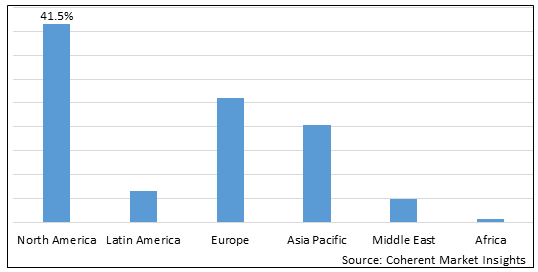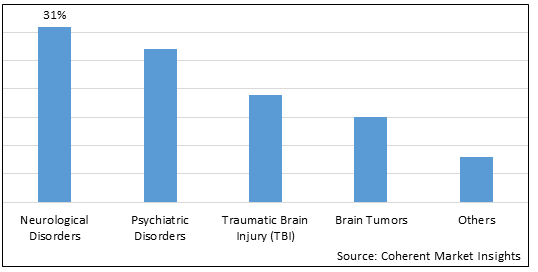Neuroimaging Market is estimated to be valued at USD 42.28 Bn in 2025 and is expected to reach USD 63.57 Bn in 2032, exhibiting a compound annual growth rate (CAGR) of 6% from 2025 to 2032.
Neuroimaging is the use of medical imaging techniques to study the structure and function of the brain and nervous system. It is used to diagnose and treat a variety of neurological disorders, including Alzheimers disease, stroke, and brain tumors. Increasing incidence of neurological disorders is a major driver of the neuroimaging market. According to the World Health Organization (WHO) 2021 estimates, neurological disorders affect 1 in every 6 people worldwide. The aging population is also a major factor driving the growth of the market, as neurological disorders are more common in older adults. Growing demand for personalized medicine is another major driver of the neuroimaging market. Personalized medicine is a field of medicine that tailors treatment to the individual patient. Neuroimaging can be used to identify the specific changes in the brain that are associated with a particular disease. This information can then be used to develop personalized treatment plans.
Neuroimaging Market Regional Insights:
- The market growth in North America region is being driven by the increasing incidence of neurological disorders, such as Alzheimers disease, stroke, and brain tumors. The high level of healthcare expenditure and the presence of a large number of imaging centers are also contributing to the growth of the market. The market share of North America is expected to be 41.5% in 2025.
- The market growth in Europe region is being driven by the factors similar to North America, as well as the presence of a large number of research institutes. The market share of Europe is expected to be 23.1% in 2025.
- The market growth in Asia Pacific region is being driven by the increasing incidence of neurological disorders, the rising disposable income of people, and the increasing government funding for research and development. The market share of Asia Pacific is expected to be 18.6% in 2025.
Figure 1. Neuroimaging Market Share (%), By Region, 2025
To learn more about this report, Download Free Sample
Analysts View of the Neuroimaging Market:
The neuroimaging market is poised to grow substantially in the near future driven by several factors. Rapid advancement in neuroimaging technologies is allowing researchers to better understand brain structure and function. Moreover, rising incidence of neurological disorders such as Alzheimers, Parkinsons, and stroke is fueling demand for neuroimaging procedures for diagnosis and treatment management. Furthermore, increasing application of functional magnetic resonance imaging (MRI) for pre-surgical mapping and tumor localization will present multiple opportunities in the market.
Neuroimaging Market Drivers:
- Advancements in imaging technology: Continuous technological advancements, such as higher resolution imaging, functional imaging, and real-time data processing, enhance the accuracy and capabilities of neuroimaging techniques. For instance, in November 2021, Royal Philips, a global health technology company; announced new artificial intelligence (AI)-enabled innovations in magnetic resonance imaging technology. The product was launched ate the annual meeting of the Radiological Society of North America. Philips new MR 5300 system which was being introduced for the first time at RSNA 2021, received 510(k) clearance from the U.S. Food and Drug Administration (FDA).
- Growing prevalence of neurological disorders: Rising incidence of neurological disorders, including Alzheimers disease, Parkinsons disease, and stroke, fuels the demand for neuroimaging tools for early diagnosis and monitoring. For instance, in 2020, according to Centers for Disease Control and Prevention, approximately 5.8 million Americans were living with Alzheimers disease.
Neuroimaging Market Opportunities:
- AI and Machine Learning Integration (MLI): Leveraging artificial intelligence and machine learning algorithms for data analysis and interpretation can enhance the accuracy and efficiency of neuroimaging techniques. For instance, in December 2021, Biogen Inc., a company focused on discovering, developing, and delivering therapies for serious neurological diseases; and TheraPanacea, a highly innovative information technology company; announced that they have entered into a collaboration focused on multiple therapeutic area in neuroscience, to build up companys existing relationship. The aim is to leverage machine learning (ML) and artificial intelligence (AI) analysis to develop digital health solutions that may improve patient care, accelerate drug development, and understand the underlying pathologies of neurological diseases.
- Remote imaging solutions: Developing remote neuroimaging solutions for telemedicine and remote patient monitoring can tap into the evolving healthcare landscape. For instance, in April 2020, GE Healthcare, a global medical technology and digital solutions innovator; introduced a new software solution to support clinicians and health systems in the treatment of COVID-19 patients. The company launched Mural Virtual Care Solution, which is designed to give hospitals a broad view across their ventilated patient population and help to identify patients at risk of deterioration, to the highly secure and trusted Microsoft Azure cloud platform.
Neuroimaging Market Report Coverage
| Report Coverage | Details | ||
|---|---|---|---|
| Base Year: | 2024 | Market Size in 2025: | USD 42.28 Bn |
| Historical Data for: | 2020 To 2024 | Forecast Period: | 2025 To 2032 |
| Forecast Period 2025 to 2032 CAGR: | 6% | 2032 Value Projection: | USD 63.57 Bn |
| Geographies covered: |
|
||
| Segments covered: |
|
||
| Companies covered: |
GE Healthcare, Siemens Healthineers, Philips Healthcare, Toshiba Medical Systems Corporation, Hitachi Healthcare, Canon Medical Systems Corporation, Mindray Medical International Limited, Esaote SpA, NeuroLogica Corporation, NeuroVive Pharmaceutical AG, Brainlab AG, Akili Interactive Labs Inc., Brainomix Ltd., Imaging Science International, Mevis Medical Solutions, NeuroVista, Neusoft Medical Systems, Positron Corporation, Shimadzu Corporation, and Trifoil Imaging. |
||
| Growth Drivers: |
|
||
| Restraints & Challenges: |
|
||
Uncover macros and micros vetted on 75+ parameters: Get instant access to report
Neuroimaging Market Trends:
- Functional imaging advancements: Increasing focus on functional imaging techniques like functional MRI (fMRI) and positron emission tomography (PET) for mapping brain activity and connectivity. For instance, in October 2022, GE Healthcare, a global medical technology and digital solutions innovator; introduces Omni Legend, the first system on its all new, all-digital PET (Positron Emission Tomography)/CT (Computed Tomography) platform. This cutting edge system features a brand-new category of digital BGO (Bismuth germanium oxide) (dBGO) detector material with a small crystal size that delivers more than two times the sensitivity of prior digital scanners, thus enabling faster total scan times and impressive small lesion detectability.
- Teleimaging and remote monitoring: Expanding applications of neuroimaging in telemedicine and remote patient monitoring enables consultations and diagnostics from a distance.
Neuroimaging Market Restraints:
- High equipment costs: The initial investment and maintenance costs of neuroimaging equipment, such as MRI and PET scanners can be prohibitively expensive for healthcare facilities.
- Limited accessibility: Accessibility to neuroimaging services may be limited in some regions, especially in low-income areas, thus leading to disparities in healthcare access.
Counterbalance: The market players should focus on increasing the availability of neuroimaging services to regions, like the low-income areas which lacks proper healthcare accessibility.
Complexity of data interpretation: The complexity of neuroimaging data analysis and interpretation requires specialized training and expertise, thus leading to challenges in resource-constrained settings.
Figure 2. Neuroimaging Market Share (%), By Applications, 2025

To learn more about this report, Download Free Sample
Recent Developments:
New product launches:
- In November 2020, Siemens Healthineers, a German company which provides healthcare solutions and services launched the Magnetom Free.Max, a high-field MRI system that is designed to be more user-friendly and efficient than traditional MRI systems. It is also more affordable, thus making it a more accessible option for patients.
- In April 2022, GE Healthcare, a leading global medical technology, pharmaceutical diagnostics, and digital solutions innovator; launched its next-generation revolution aspire computer tomography (CT) scanner. Revolution aspire is an advanced imaging solution that is designed and manufactured end-to-end in India, at the newly launched Wipro GE Medical Devices Manufacturing plant, in line with Atmanirbhar Bharat initiative. The CT system is equipped with higher imaging intelligence to improve clinical confidence when diagnosing diseases and anomalies.
Acquisition and partnerships:
- In 2022, General Electric Company, an American multinational conglomerate (GE Healthcare) acquired Sentimag, a company that develops AI-powered solutions for neuroimaging, to help GE Healthcare Company (GE Healthcare) to expand its portfolio of AI-powered solutions for neuroimaging.
- In May 2023, Siemens Healthineers, a leading medical technology company and CommonSpirit Health, a nonprofit, catholic health system dedicated to advance health for all people, acquired Block Imaging, a provider of services and products to health care providers with new and refurbished diagnostic imaging. This acquisition will help in providing more sustainable options and support increasing demand from the U.S. hospitals, health systems, and other care sites for multi-vendor imaging parts and services.
Top Companies in Neuroimaging Market
- GE Healthcare
- Siemens Healthineers
- Philips Healthcare
- Toshiba Medical Systems Corporation
- Hitachi Healthcare
- Canon Medical Systems Corporation
- Mindray Medical International Limited
- Esaote SpA
- NeuroLogica Corporation
- NeuroVive Pharmaceutical AG
- Brainlab AG
- Akili Interactive Labs Inc.
- Brainomix Ltd.
- Imaging Science International
- Mevis Medical Solutions
- NeuroVista
- Neusoft Medical Systems
- Positron Corporation
- Shimadzu Corporation
- Trifoil Imaging
Definition: The neuroimaging refers to the commercial sector within the healthcare industry that is focused on the development, production, distribution, and application of various imaging technologies and techniques which is designed to visualize and assess the structure, function, and abnormalities of the human brain and nervous system. Neuroimaging plays a critical role in diagnosing, monitoring, and researching neurological and psychiatric disorders, thus aiding in clinical decision-making and advancing our understanding of the brain.
Few Other Promising Reports in Healthcare IT Industry
Medical Imaging Reagents Market
Medical Imaging Analysis Software Market
Share
Share
About Author
Komal Dighe is a Management Consultant with over 8 years of experience in market research and consulting. She excels in managing and delivering high-quality insights and solutions in Health-tech Consulting reports. Her expertise encompasses conducting both primary and secondary research, effectively addressing client requirements, and excelling in market estimation and forecast. Her comprehensive approach ensures that clients receive thorough and accurate analyses, enabling them to make informed decisions and capitalize on market opportunities.
Missing comfort of reading report in your local language? Find your preferred language :
Transform your Strategy with Exclusive Trending Reports :
Frequently Asked Questions
Select a License Type
EXISTING CLIENTELE
Joining thousands of companies around the world committed to making the Excellent Business Solutions.
View All Our Clients




